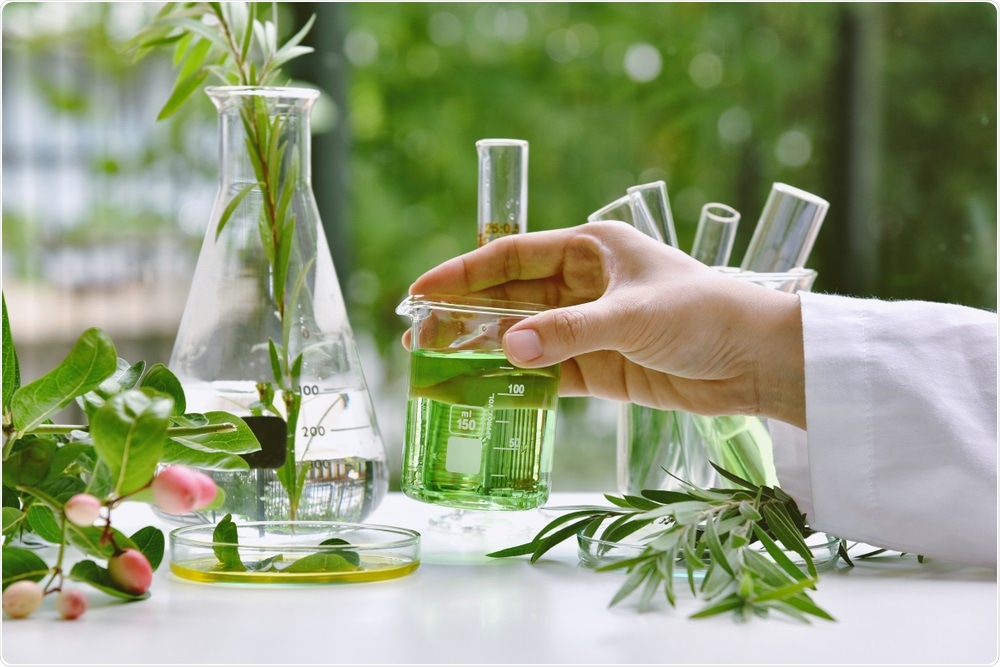The severe acute respiratory syndrome coronavirus 2 (SARS-CoV-2) is remarkably resistant to treatments. To date, there is no drug that has been deemed as fully effective in treating the coronavirus disease 2019 (COVID-19); therefore, there remains an urgent need for potent and safe antivirals against SARS-CoV-2.
A new study published in the journal Pharmaceuticals identifies a potent SARS-CoV-2 antiviral, Pheophorbide a (PheoA), which is a compound derived from the plant Marchantia polymorpha L.
 Study: SARS-CoV-2 Fears Green: The Chlorophyll Catabolite Pheophorbide A Is a Potent Antiviral. Image Credit: ARTFULLY PHOTOGRAPHER / Shutterstock.com
Study: SARS-CoV-2 Fears Green: The Chlorophyll Catabolite Pheophorbide A Is a Potent Antiviral. Image Credit: ARTFULLY PHOTOGRAPHER / Shutterstock.com
Drugs to combat COVID-19
In the current pandemic, efforts are focused on developing vaccines and identifying antiviral compounds. As a result, the current strategy relies on repurposing existing drugs.
Even with ongoing vaccination campaigns, breakthrough infections have been found to occur with certain variants. Some of the drugs that have been approved for COVID-19 treatment, like Remdesivir (RMDV), Favipiravir, or its derivative Avifavir, have a mild effect against the virus. Other treatments like Chloroquine and Hydroxychloroquine appear to benefit only a subgroup of patients. However, the possible side effects of these drugs are under investigation.
Certain compounds like Aplidin, Mefloquine, Nelfinavir, Protoporphyrin IX, and Verteporfin have demonstrated antiviral activity in in vitro assays and some in vivo models. Nevertheless, there is a need to identify new potent and safe antivirals against SARS-CoV-2.
Plant metabolites as drugs
Traditional medicine utilizes plants as a source of therapeutics. Today, plants are the main source of compounds in pharmacology. Plants have a rich metabolism that equips them with chemical weapons to combat environmental biotic stresses, including viruses.
Identifying new plant metabolites paves the way to the discovery of new drugs. Metabolic engineering can further help in optimizing these drugs.
Bryophytes are non-vascular plants that include mosses and liverworts. These plants are rarely infected by fungi, bacteria, or viruses in their natural habitats, thus indicating the presence of defense metabolites.
Several liverwort species including Marchantia polymorpha L. produce terpenoids and bisbibenzyls that have an enormous potential for pharmaceutical applications. These compounds demonstrate antimicrobial, antioxidant, cytotoxic, anticancer, and antiviral properties.
In the current study, scientists explore the potential of Marchantia polymorpha L. as a source of antivirals against SARS-CoV-2.
Antiviral from Marchantia extracts
In the current study, the scientists made crude extracts of two different M. polymorpha subspecies including ruderalis from Japan and polymorpha from Spain. These extracts were subsequently tested on Vero E6 cells infected with the SARS-CoV-2 NL2020 strain. Total extracts from all the plants displayed a remarkable antiviral activity against SARS-CoV-2.
The scientists identified the antiviral metabolite as Pheophorbide a (PheoA) using a bioactivity-guided chromatographic approach, in addition to mass spectrometry (MS). PheoA is a porphyrin chlorophyll derivative very similar to animal Protoporphyrin IX.
Antiviral activity of PheoA
To confirm the antiviral potential of PheoA, the scientists investigated the antiviral activity of commercially available PheoA. Vero E6 and Huh7-ACE2 cells, the latter of which are human hepatoma cells expressing the angiotensin-converting enzyme 2 (ACE-2) receptor, were inoculated with PheoA and SARS-CoV-2. PheoA demonstrated protective capacity in both cell lines.
The scientists employed reverse-transcriptase quantitative polymerase chain reaction (RT-qPCR) to determine the extracellular viral ribonucleic acid (RNA) load in human cells inoculated with SARS-CoV-2. PheoA was found to reduce viral RNA accumulation in a dose-dependent manner.
Previous studies have shown that PheoA acts as an antiviral against the hepatitis C virus (HCV) and virucidal against herpes simplex virus (HSV). The scientists determined the antiviral spectrum of PheoA against different enveloped RNA viruses. The effectiveness of PheoA was tested against four different recombinant RNA viruses expressing reporter genes including HCV, hCoV-229E, West Nile Virus (WNV), and vesicular stomatitis virus (VSV).
PheoA showed a broad-range antiviral activity against these enveloped RNA viruses.
PheoA and RMDV
Combination treatments were performed with increasing doses of PheoA and RMDV. The drugs and both SARS-CoV-2 were incubated with Vero E6 cells.
Increasing concentrations of PheoA improved RMDV efficacy and vice versa, thus demonstrating a mostly additive effect of this drug combination. This suggests that combinations of PheoA with other antivirals may be beneficial.
PheoA, with very low toxicity, therefore proved to be a suitable candidate for antiviral therapy against SARS-CoV-2.
PheoA mode of action
To investigate the mode of action of PheoA, the scientists assessed its antiviral efficacy when PheoA was present at all times during an experiment, added only during virus inoculation, or added only after virions had effectively penetrated the cells in single-cycle infection experiments. PheoA mainly acted at the early stages of the infection, potentially at the level of viral entry.
The scientists determined the antiviral activity of PheoA in a surrogate model of infection. This model recapitulates aspects related to viral entry such as receptor recognition, virion internalization, or membrane fusion. PheoA barely interfered with the retroviral pseudotype infection efficiencies. This surrogate model of viral entry indicated that PheoA does not interfere substantially with molecular events leading to viral entry.
Previous studies have demonstrated that PheoA irreversibly interferes with the virion infectivity in HSV and influenza infection models. Therefore, the scientists explored the virucidal activity of PheoA.
SARS-CoV-2 particles were subsequently pre-incubated with increasing doses of PheoA before inoculating the cells. Pre-incubation of the infectious virions with PheoA resulted in a dose-dependent reduction in the remaining virus infectivity.
Incubation of the virus at room temperature for up to 15 minutes in the presence of PheoA did not affect virus infectivity. However, longer incubation periods reduced SARS-CoV-2 infectivity.
Thus, exposure to PheoA reduced the virus infectivity in a time- and dose-dependent manner. This indicated that PheoA is virucidal for SARS-CoV-2 virions and that virion infectivity inactivation provides it an overall antiviral effect.
Conclusion
In conclusion, PheoA displayed a remarkable potency and a satisfactory therapeutic index, thereby supporting its potential as a candidate for antiviral therapy against SARS-CoV-2.
- Jimenez-Aleman, G.H., Castro, V., Londaitsbehere, A., et al. (2021). SARS-CoV-2 Fears Green: The Chlorophyll Catabolite Pheophorbide A Is a Potent Antiviral. Pharmaceuticals. 2021;14(10). doi:10.3390/ph14101048.
Posted in: Medical Science News | Medical Research News | Disease/Infection News
Tags: ACE2, Angiotensin, Angiotensin-Converting Enzyme 2, Antioxidant, Bacteria, Cell, Chlorophyll, Chloroquine, Compound, Coronavirus, Coronavirus Disease COVID-19, Drugs, Efficacy, Enzyme, fungi, Genes, Hepatitis, Hepatitis C, Herpes, Herpes Simplex, Herpes Simplex Virus, Hydroxychloroquine, in vitro, in vivo, Influenza, Mass Spectrometry, Medicine, Mefloquine, Membrane, Metabolism, Metabolite, Metabolites, Pandemic, Pharmaceuticals, Pharmacology, Polymerase, Polymerase Chain Reaction, Receptor, Remdesivir, Respiratory, Ribonucleic Acid, RNA, SARS, SARS-CoV-2, Severe Acute Respiratory, Severe Acute Respiratory Syndrome, Spectrometry, Stomatitis, Syndrome, Therapeutics, Vascular, Virus, West Nile Virus

Written by
Dr. Shital Sarah Ahaley
Dr. Shital Sarah Ahaley is a medical writer. She completed her Bachelor's and Master's degree in Microbiology at the University of Pune. She then completed her Ph.D. at the Indian Institute of Science, Bengaluru where she studied muscle development and muscle diseases. After her Ph.D., she worked at the Indian Institute of Science, Education, and Research, Pune as a post-doctoral fellow. She then acquired and executed an independent grant from the DBT-Wellcome Trust India Alliance as an Early Career Fellow. Her work focused on RNA binding proteins and Hedgehog signaling.
Source: Read Full Article
